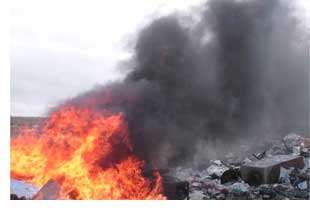Burning:
 Burning
of household waste is a major source of toxic emissions that damage both human health and the environment. The smoke from burning
household waste in a burn barrel or open dump is released close to the ground where people can easily breathe it. The smoke can also
deposit hazardous substances on subsistence foods. Young children may be at greater risk than adults because of their playing behaviors
and their small size and developing bodies. Open burning can also be the cause of residential, brush, and forest fires.
Burning
of household waste is a major source of toxic emissions that damage both human health and the environment. The smoke from burning
household waste in a burn barrel or open dump is released close to the ground where people can easily breathe it. The smoke can also
deposit hazardous substances on subsistence foods. Young children may be at greater risk than adults because of their playing behaviors
and their small size and developing bodies. Open burning can also be the cause of residential, brush, and forest fires.Burn barrels smolder, and rarely reach temperatures over 500 degrees Fahrenheit, which means combustion is incomplete and greater amounts of harmful chemicals are released into the air. Permitted incinerators operate at 1,800 degrees Fahrenheit to insure complete combustion, and they use efficient filters to reduce harmful emissions. Burning about 10 pounds of trash a day in a household burn barrel may produce as much air pollution as a modern, well-controlled incinerator burning 400,000 pounds of trash a day. Burn barrels release large quantities of dioxins and furans which are considered some of the most toxic man-made compounds. The EPA estimated the emissions of dioxins and furans (on a toxicity-weighted basis) from backyard burning alone are greater than for all other sources combined for the years 2002-2004.
The burning of buildings and other structures solely for the purpose of demolition is not an acceptable environmental practice. If a permit is received to burn abandoned buildings all reasonable measures should be taken to remove the following materials from the structure prior to burning:
- Asbestos insulation, siding, shingles and other materials
- Urea formaldehyde foam insulation
- Vinyl siding
- Synthetic carpets
- Linoleum
- Fluorescent fixtures including the ballast and fluorescent tubes
- Glycols from heating systems
- Refrigerant agents (i.e. chlorofluorocarbons and ammonia) from refrigeration and air conditioning systems
- PVC and ABS piping and other plastics, where accessible
- Thermostats that contain mercury switches
- Fire extinguishers
- Rubber
- Pesticides, paints, solvents and cleaning, maintenance and other unused chemicals
- Smoke detectors
- Treated wood, where practical
Contaminants of Concern:
It is difficult to tell exactly all the compounds that are released from burning waste. What comes out depends on the types of trash that went in, the temperature of the fire and the availability of oxygen. Here are some of the air pollutants that have been found in the smoke from a burn barrel and their potential health risks:- Dioxins and furans (immune suppressions, hormone system disruption, cancer)
- Benzene (leukemia)
- Formaldehyde (eye, nose and throat irritant, difficulty in breathing, skin rashes, cancer)
- Particulate matter (respiratory problems, cardiac arrhythmia, heart attacks)
- Polycyclic aromatic hydrocarbons (cancer)
- Hydrogen chloride (corrosive to the eyes, skin, and mucous membranes, may cause respiratory tract irritation and chronic bronchitis)
- Hydrogen cyanide (neurological, respiratory, cardiovascular, and thyroid effects)
- Carbon monoxide (reduces the oxygen-carrying capacity of the blood)
- Ash which may contain the following heavy metals:
- Cadmium (lung damage, kidney disease)
- Arsenic (gastrointestinal problems, anemia, kidney and liver disease, cancer)
- Mercury (nervous system and kidney damage)
- Chromium (respiratory effects, cancer)
- Cadmium (lung damage, kidney disease)
Although substances such as particulate matter, carbon monoxide and formaldehyde can cause immediate health effects with enough exposure, some chemicals such as dioxin can build up in foods and in your body. Some of these chemicals can remain on your property (for example, soil outside and dust inside your home).
Implementing Solutions:
Please submit your experiences (successes/challenges) and tribal-specific documents to share on our website using the attached form.Download Form
Resources:
Reducing Backyard Burning on the Yurok Indian Reservation Brochure [pdf]EPA Brochure Tribal Leaders are Key to Reducing Backyard Burning [pdf]
EPA Brochure Reducing Backyard Burning in Indian Country [pdf]
Great Lakes Binational Toxics Strategy: Strategy/Implementation Plan for Reducing the Prevalence of Household Garbage Burning (Barrel Burning) in Rural Areas of the Great Lakes [pdf]
State of Alaska Burning Garbage and Land Disposal in Rural Alaska: A Publication for Small Alaska Communities Considering Incineration and Energy Recovery [pdf]
Zender Environmental Health and Research Group: Improved Combustion and Emissions for MSW Burn-Management Unit Applicable to Remote Communities in Alaska [pdf]
Zender Environmental Health and Research Group: Health Effects of Burning Trash [pdf]
Websites:
Tulalip Tribes Air Quality Enforcement:www.tulaliptribes-nsn.gov/air_quality/enforcement.htm
Federal Air Rules for Indian Reservations (FARR) in Idaho, Oregon, and Washington:
www.epa.gov/farr
Dioxins Produced by Backyard Burning:
www.epa.gov/dioxin/dioxins-produced-backyard-burning
Zender Environmental Health and Research Group A-Z Index: Burning Documents:
www.zendergroup.org/viewdocs.htm
Related Pages:
Abandoned/Unsafe Buildings and StructuresIncinerators
RCRA
For more information, please contact:
Jennifer Williams, Alaska Program Coordinator, Sr.
Tel: 928/523-0673
Email: Jennifer.Williams@nau.edu
Tel: 928/523-0673
Email: Jennifer.Williams@nau.edu
Last updated: July 10, 2015
